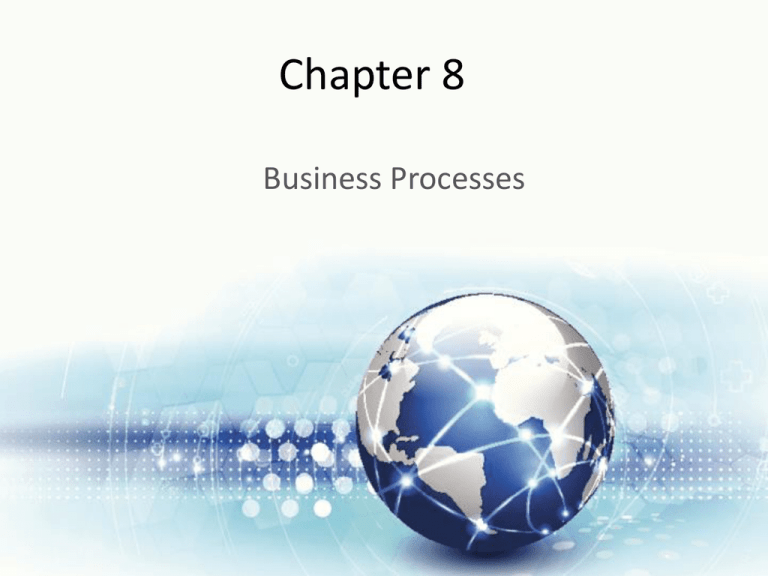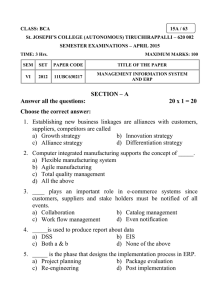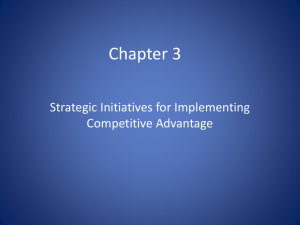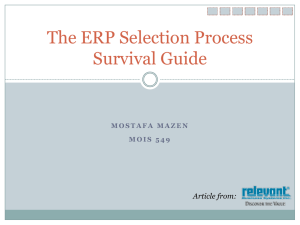business process
advertisement

Chapter 8 Business Processes Learning Objectives Upon successful completion of this chapter, you will be able to: • define the term business process; • identify the different systems needed to support business processes in an organization; • explain the value of an enterprise resource planning (ERP) system; • explain how business process management and business process reengineering work; and • understand how information technology combined with business processes can bring an organization competitive advantage. What is a business process? • A process is a series of tasks that are completed in order to accomplish a goal. • A business process, therefore, is a process that is focused on achieving a goal for a business. • Processes are something that businesses go through every day in order to accomplish their mission. • The better their processes, the more effective the business. Documenting a Process • The simplest way to document a process is to simply create a list. • How to create an account on eBay, might look like this: 1. Go to ebay.com. 2. Click on “register.” 3. Enter your contact information in the “Tell us about you” box. 4. Choose your user ID and password. 5. Agree to User Agreement and Privacy Policy by clicking on “Submit.” Documenting a Process • A list is not good enough for some processes. Below is a process diagram to determine if a new term should be added to Wikipedia. Managing Business Process Documentation • The requirement to manage process documentation has been one of the driving forces behind the creation of the document management system. • A document management system stores and tracks documents and supports the following functions: – Versions and timestamps. – Approvals and workflows. – Communication. • A document management system will notify the appropriate people when a change to a document is approved. ERP Systems • An enterprise resource planning (ERP) system is a software application with a centralized database that can be used to run an entire company. ERP Systems • All data in an ERP system is stored in a single, central database. • data entered in one part of the company can be immediately available to other parts of the company. • An ERP can be used to manage an entire organization’s operations. • Companies need to purchase modules for an ERP that represent different functions within the organization. • Some companies choose to purchase many modules, others choose a subset of the modules. ERP modules • When an ERP vendor designs a module, it has to implement the rules for the associated business processes. • These rules reflects the best practices for that process within a giving industry. • The implementation of an ERP system is an excellent opportunity to improve their business practices. ERP challenges • Is the process embedded in the ERP really better than the process they are currently utilizing? • Can a company differentiate from its competitors if they use the same ERP system? • Can a ERP be customized to match a given organization processes? (Yes, but who “manage” the customized system?) ERP vendors • Some of the best-known ERP vendors are: – SAP – Microsoft – ORACLE (People Soft) – INFOR (mid size and small organizations) ERP and organizational value • ERP vendors combine subset of ERP modules to offer applications with high impact on the organizations. • The most important ones are: – Customer Relationship Management (CRM) systems – Supply Chain Management (SCM) systems. ERP and customer relationship management • CRM systems allow to managing a company’s interaction with current and future customers. • We are familiar with CRM systems from companies that we do business with: – Your car dealer send you a letter (or card) letting you know that your card need service. – Netflix recommends you new movies to watch. – Expedia send you offers for cities you have visited. • https://www.youtube.com/watch?v=XmnPlfJh7z M Advantages of CRM Systems • Allows track goals and metrics for sales, marketing, and customer services. • Increase customer retention • Increase profitability • Facilitate to identify “who are your customers” • Permits to know “what is important to your customers” • Allows opportunity management ERP and Supply Chain Management • Supply chain management has been defined as the "design, planning, execution, control, and monitoring of supply chain activities with the objective of creating net value, building a competitive infrastructure, leveraging worldwide logistics, synchronizing supply with demand and measuring performance globally.” (APICS 2013). • SCM draws heavily from the areas of operations management, logistics, procurement and information technology, and aims for an integrated approach to optimize the flow of good and services. (Bartch 2013) SCM examples • Dell • https://www.youtube.com/watch?v=owQzo82 ac_M • Walmart • https://www.youtube.com/watch?v=yZC4neLa x5o Advantages of SCM Systems • • • • • • Secure accurate SCM metrics Help controlling bullwhip effect Facilitate visualization of SCM metrics Improve productivity Increase profitability Help to integrate value systems Business Process Management • The literature report three alternatives to business process manage: • Automatize • Streamlining • Business process engineering Automation • While automation can make a business more efficient, it cannot be used to provide a competitive advantage. • Simply automating a bad process does not make it better. • Organizations that are serious about improving their business processes will also create structures to manage those processes. • Business process management (BPM) can be thought of as an intentional effort to plan, document, implement, and distribute an organization’s business processes with the support of information technology. Streamlining • Streamlining has a better impact on efficiency and productivity, but it cannot warranty a competitive or sustainable advantage. • It is a good strategy for process that are essential to the company but they cannot bring competitive advantage. • Business process management will provide several key benefits to an organization, which can be used to contribute to competitive advantage. Business process management The benefits of business process management include: • Empowering employees. • Built-in reporting. • Enforcing best practices. • Enforcing consistency. Business process reengineering • Organizations look to manage their processes to gain a competitive advantage. • Companies should “blow up” their existing processes and develop new processes that take advantage of the new technologies and concepts. • Do not optimize, obliterate (Hammer 1990.) • BPR is fully understanding the goals of a process and then dramatically redesigning it from the ground up to achieve dramatic improvements in productivity and quality. How to do BPR (Hammer) • Organize around outcomes, not tasks. • Have those who use the outcomes of the process perform the process. • Subsume information-processing work into the real work that produces the information. • Treat geographically dispersed resources as though they were centralized. • Link parallel activities instead of integrating their results. • Put the decision points where the work is performed, and build controls into the process. • Capture information once, at the source. Sidebar: Reengineering the College Bookstore Summary • Define the term business process; • Identify the different systems needed to support business processes in an organization; • Explain the value of an enterprise resource planning (ERP) system; • Explain how business process management and business process reengineering work; and • Understand how information technology combined with business processes can bring an organization competitive advantage.







